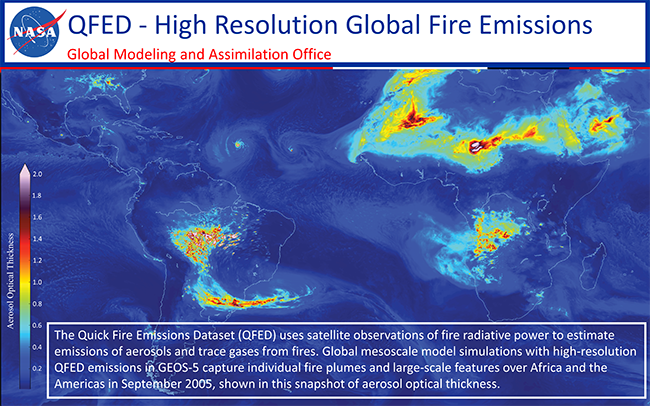QFED - High Resolution Global Fire Emissions
Biomass burning is an important source of particulates and trace gases and an important element of the terrestrial carbon cycle. Well constrained emissions from fires are needed to model direct and indirect effect of biomass burning aerosols, homogeneous and heterogeneous chemistry in the atmosphere, and to perform credible integrated earth system analysis, climate and air pollution studies.
The Quick Fire Emissions Dataset (QFED) was developed to enable biomass-burning emissions of atmospheric constituents to be included in the NASA Goddard Earth Observing System (GEOS) modeling and data assimilation systems. The QFED emissions are based on the fire radiative power (FRP) approach and draw on the cloud correction method developed in the Global Fire Assimilation System (GFAS), QFED however employs more sophisticated treatment of non-observed (e.g., obscured by clouds) land areas. Location and FRP of fires are obtained from the Moderate Resolution Imaging Spectroradiometer (MODIS) Level 2 fire products (MOD14 and MYD14) and the MODIS Geolocation products (MOD03 and MYD03). Major advantages of QFED are the high spatial and temporal resolutions, and near-real time availability. Currently, QFED provides daily-mean emissions of black carbon, organic carbon, sulfur dioxide, carbon monoxide, carbon dioxide, PM2.5, ammonia, nitrogen oxides, methyl ethyl ketone, propylene, ethane, propane, n- and i-butane, acetaldehyde, formaldehyde, acetone and methane.
QFED emissions at 0.1x0.1 degrees horizontal resolution were used in the 7-km GEOS-5 Nature Run experiment (NR-c1440) to provide global fire emissions for the interactive aerosol chemistry simulated with an online implementation of the Goddard Chemistry, Aerosol, Radiation, and Transport model (GOCART). An example of instantaneous aerosol optical thickness (AOT) in September 2005 shows that the global mesoscale simulation benefited from the high resolution QFED emissions and was able to produce realistic individual fire plumes as well as large scale features from fires in Africa and the Americas.


